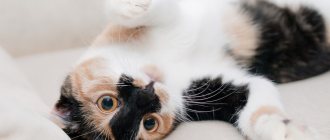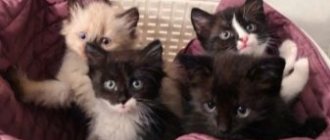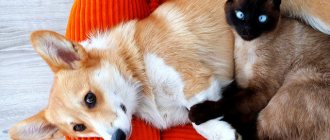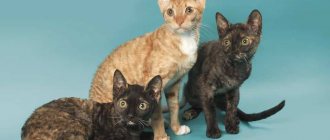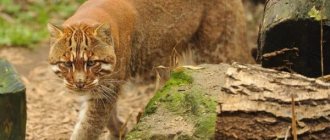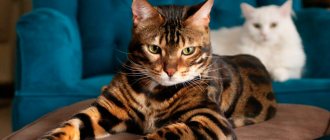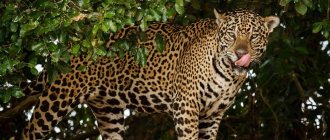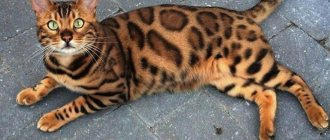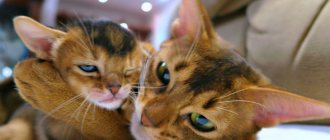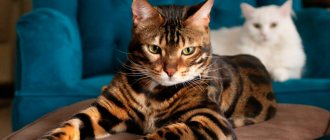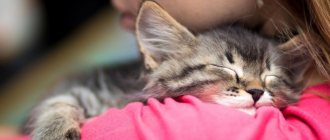The cat's face measurements were fed into an online calculator, which measured how closely each cat's proportions matched the golden ratio, which is approximately 1.62. The golden ratio has been used for centuries to evaluate the "correctness" of shapes and proportions. This is the best and unique relationship of parts and the whole, which is considered to be the most beautiful. The Golden Ratio, or as it is also called the “Divine Proportion,” can be observed in nature, art and science. Based on this proportion, the All About Cats portal decided to identify the most beautiful cat breeds.
Gray cats are not uncommon
Gray color, also called blue, is not uncommon in the cat community. In addition to pure gray, there are options with a variety of patterns: tabby, calico, tortoiseshell, etc. Of course, representatives of some breeds are only gray (for example, Russian Blue), which creates the impression that such cats are rare, although in fact gray wool is quite common. .
How to choose a kitten
Since the Norwegian breed can be confused with the Siberian and Coons, you need to choose kittens especially carefully. It is better to choose reliable nurseries that value their reputation and name. The risk of getting an individual with a cross is minimal. When choosing a kitten, you should follow some recommendations:
- availability of genetic tests for the presence of hereditary diseases;
- small kittens should be active, play with each other, and make good contact with humans;
- gums should be pink;
- the eyes have no clouding or discharge;
- the tail is straight, without creases or bends;
Many people choose a pet based on its color. The cost of the animal largely depends on this factor.
What is the price
The price of a cat depends on the reputation of the cattery, color, pedigree and other factors. The average cost of a kitten is 35-45 thousand rubles. Show-class individuals can cost up to 150,000 rubles.
How to name a kitten
The name for a kitten of the Norwegian breed is often chosen from the mythology of the ancient Vikings. The most common nicknames include the following:
Table of popular names for cats and cats.
Breeding Features
This breed appeared in our country relatively recently. In many ways, this is why kittens are expensive. Finding a good, reliable nursery, especially in some cities, will be problematic.
Breeding these animals does not have any special difficulties or difficulties. The most important issue is finding a mating partner.
Manx tailless
These cats appeared due to a random gene mutation. The Isle of Man is considered their homeland. A feature of the breed is a residual tail measuring no more than 3 cm in length or its absence. The shape of the cat resembles a ball. It has large eyes, medium-sized ears with a pointed end, and a short neck. The front legs are shorter than the hind legs, the coat is two-layered, with short undercoat.
Cats easily get used to new living conditions and can easily tolerate moving. Parting with the owners can cause deep trauma to the moral health of the animal. They love to jump and gallop, frequent walks and games. Children are treated with caution: they will not allow themselves to be pulled by their ears or short tail. They are very brave and will rush into battle if their owner is threatened.
They are in good health and like to drink cold water.
Neva Masquerade
The masquerade of a beautiful fluffy cream-colored cat is given by special dark markings on the face. Cats of this breed are large (7–10 kg) and have long hair.
Photo: pixabay.com: UGC
Origin
The breed is the result of crossing a Siberian cat with a Persian and a Siamese. Thanks to this, the cat received long hair and a color point color. The breed was bred by St. Petersburg breeders in 1989, but did not receive international recognition.
Appearance and character
Representatives of the breed are large animals with a trapezoidal head, round, large blue eyes, massive paws and a long, bushy tail. The Neva Masquerade has long hair. These cats are affectionate, but do not tolerate familiarity. They are friends with children and pets.
Care
Pay special attention to the coat, especially during the shedding period (occurs twice a year): you will need a brush. Bathe your masquerade no more than three times a year.
Nibelung
Muscular and lean Nibelungs are a godsend for active people. They are active, affectionate and sociable. These cats gain up to 6 kg of weight (females - up to 4 kg), have a luxurious coat, and the cats are fluffier than males.
Photo: pixabay.com: UGC
Origin
Representatives of this breed are indirectly related to the “Song of the Nibelungs”. The first representatives received from the owners the names of the main characters of this saga. They were born in the early 1980s. in the USA as a result of crossing a long-haired yard cat with a Russian blue cat.
Appearance and character
The main feature of the Nibelung is its luxurious smoky coat and emerald eyes. These are smart and restrained cats in their displays of emotions. Their distinguishing feature is responsiveness. They become attached to one of the owners, pay attention to him, but do not get bored.
Care
Nibelungs need to be brushed regularly and bathed as needed using a special shampoo. Pay special attention to your pet’s teeth: brush and buy special food that will remove tartar.
Munchkin
Munchkin is a cat, the heroine of the novel “The Wizard of Oz” by Lyman Baum. This is a breed of dwarf semi-longhaired cats. The height at the withers of the animals reaches 16 cm, and the weight is no more than 4 kg.
Photo: pixabay.com: UGC
Origin
Scientists found mentions of the breed in records of the 19th century; munchkins were registered in the early 1980s. Then the foundling cat (Louisiana) gave birth to cute short-legged cats, and later it was proven that this miniature is the result of mutations. The breed received recognition in 1995.
Appearance and character
The elongated body, short legs, wide head, pointed downward, expressive almond-shaped eyes of munchkins have become a reason for comparison with dachshunds. These cats often have heterochromia, a variety of colors, rare - chocolate and marbled.
Videos about cats of this breed will show how friendly and playful they are. Cats love walks and walk easily on a leash.
Care
To the usual hygienic procedures (combing, cleaning ears, teeth and eyes), add dietary control. Munchkins should not be overfed.
Diseases and health problems
Evolution and natural selection in conditions of constant frost have formed good immunity in the Norwegian breed. Human intervention in this process made its own adjustments. These cats are prone to a number of diseases:
Restructive cardiomyopathy. Deterioration in the elasticity of the muscle tissue of the heart, as a result of which heart failure develops, which can cause the death of the animal.- Diabetes and other endocrine system disorders.
- Arthrosis of the hip bones.
- Retinal dysplasia. It is an abnormal formation of the structure of the layers of the retina, which occurs in the prenatal period.
- Chronic renal failure.
- Glycogenosis. The disease disrupts metabolic processes in the liver. Typically, kittens with this disease are born dead or nonviable. Some individuals can live up to 4-6 months.
- Purivate kinase deficiency. A decrease in the number of red blood cells in the blood and the development of anemia.
The last two diseases are rare. Professional breeders, in order to avoid such consequences, conduct special blood tests, and are also picky about the choice of partners for mating.
If an animal receives proper nutrition and timely vaccination, the average life expectancy of an animal approaches 15-17 years.
Redgall
Representatives of the Redgall breed charm with their easy-going nature, kind disposition and elegant color. Redgall cats can weigh up to 12 kg, female cats are three times lighter - up to 4 kg. Cats grow up to 4 years old and grow up to 1 m in length.
Photo: pixabay.com: UGC
Origin
The breed appeared in the early 1960s. in the USA thanks to the efforts of breeder Anne Baker. Redgalls were bred by crossing Persians and Burmese cats that are white and interspersed with black. The breed was recognized in 1993.
Appearance and character
The standard color of the breed is light with a dark muzzle, paws, ears and tail. Cats of this breed have a round muzzle, slanted, expressive oval eyes (blue only) and straight ears. The long hair is collected in a collar on the neck, between the claws. A distinctive feature is a long fluffy tail.
Translated from English, Redgall means “rag doll”: when the cat falls into the hands of a person, it goes limp, becomes pliable and relaxed. There is a danger in this property of the breed: a red goll can fall and get injured because it does not have time to group itself. He is easy to train, not vindictive and not annoying.
Care
The long hair of the Red Goll does not require special care: brush once a day. Try to refrain from bathing, because these cats hate water. They are unpretentious in food, but need a balanced diet. Red golls have a weak heart, which can cause sudden death, and are prone to hip dysplasia.
Scottish lop-eared
The Scottish Fold cat or Scottish Fold gets its name from the shape of its ears. They are small and slightly crooked; against the background of large round eyes, you get the feeling that they are not there at all. Moreover, kittens are born with normal ears; they begin to develop after 21 days. This breed has short, silky fur that can be of any color. These are hardy cats, can adapt to any habitat, are friendly and affectionate, unforgiving, and love to purr on their owner’s lap.
Origin story
The domestic cat is a companion animal that has lived alongside humans for over ten thousand years.
The first wave of its spread around the world occurred with the emergence of agriculture, twelve thousand years ago, mainly in the Middle East. The second contributed to the settlement of cats that migrated with humans from Egypt to Europe and North Africa.
The first wild animal, from which our pets originated, appeared on the planet more than 130 thousand years ago. This is a steppe cat that still lives in Africa.
The first pets most likely appeared in Anatolia - the territory of modern Turkey. Their appearance near humans is associated with the development of agriculture, the availability of food in sufficient quantities and the need to protect supplies from rodents and small predators. It was from the east that the companion animal came to Cyprus and Ancient Egypt.
Scientists have differing opinions about whether cats are fully domesticated animals or not. This independent animal is capable of returning to the wild at any time. Unlike the dog, which lost its hunting skills during evolution, the blood of the ancient ancestors in the cat is very strong.
This is a friend, companion, and sometimes assistant and protector, he simply lives nearby and allows himself to be loved. Whether a person has tamed a cat or whether it has taken his heart and soul and holds it in her tender claws is a difficult question.
Over centuries of coexistence, people deified and worshiped the cat. And now they continue to serve her. However, these smartest creatures respond to people with no less love and affection.
Initially, starting with the wild steppe cat, these animals were only short-haired. The long hair of many breeds is the result of natural or artificial mutations.
But many representatives of the cat world today are short-haired and delight the aesthetic sense with their shiny coat of various quality and colors.
Read the article about the forest cat, the true ancestor of our domestic cats.
Fact about cats
Over millions of years, the cat family has adapted to various conditions in the wild, making them excellent hunters! But, despite thousands of years of friendship with people, they managed to retain the hunter's instinct!
Go to the sections to the left of the article, where you will learn in more detail about domestic cats and everything connected with them!!
Cat family
These are predatory animals that live on all continents of the planet except Antarctica. The smallest are domestic cats, the largest are lions and tigers. All cats, small and large, have acute hearing, sense of smell, excellent vision, incredible agility and quick reactions. Lions and tigers have enormous physical strength. A lion, for example, can break the backbone of a zebra or buffalo with a blow of its paw. A tiger can kill an animal 8 times its weight and get into a fight with a bear. There are cases where a lion or tiger dragged the carcass of a dead animal, weighing about a ton, along the ground for several miles!
Why a purebred pet?
Choosing a pet is not an easy task. Nowadays it has become popular to purchase purebred cats. Each breed is beautiful and graceful in its own way, plus, with such a cat you can take pride of place at the exhibition. But you shouldn’t judge a cat by its appearance, it should suit your style and lifestyle. The catalog contains a lot of useful information about animals: appearance, temperament, necessary care. Representatives of the Persian and Angora breeds require special care, but they are not so dependent on human interaction. Are you at home most of the time and want some fun? Buy a Siamese or Abyssinian cat. If you have small children at home, you need a pet with a lot of patience in order to withstand all this squeezing. A British or Scottish cat would be a good nanny.
Diversity of the cat world
The world of cats is diverse. They differ in color, eye shape, fur length, character and other equally important criteria. There are a large number of organizations involved in developing standards and registering breeds. How a relationship develops with a pet depends on the person. For a cat, the owner is the most adored person on earth; his betrayal will leave a scar on the animal’s soul. For humans, a cat is a healing salvation from depression and bad mood, a fluffy little ball that can warm the heart on the coldest evenings.
Angora (Turkish) longhair
An Angora or Turkish cat is a reliable friend. Angora is a medium-sized cat. An adult weighs up to 5 kg and reaches 30 cm in height at the withers. They have long hair with thick down. Cats live up to 20 years.
Photo: pixabay.com: UGC
Origin
This is one of the most ancient breeds along with the Egyptian Mau, Serval and Caracal. In ancient times, their habitat was the Byzantine Angara (Ankara). Hence the modern name of the breed.
Angora kittens came to Europe in the 15th century thanks to the knights. Later, merchants began to import them. In the 20th century, the breed was on the verge of extinction. The breed was preserved by enthusiasts: the Angora was declared a national treasure of Turkey and an export ban was imposed.
Appearance and character
Angoras are graceful snow-white beauties with semi-long hair and heterochromia - multi-colored eyes. The fluffy and soft hair on the neck forms a collar, on the hind legs there is a riding breeches, and on the tail it looks like long ostrich feathers.
The classic color of the Angora cat is white, but at the beginning of 1994 other colors were approved at the international level. Angora cats are smart, inquisitive, sociable and active.
Care
Despite the special density and length of the coat, Angoras are unpretentious in care. The owner only needs to brush the pet twice a week with a special brush, bathe it once a month using a special shampoo, and perform eye and ear hygiene.
Persian
A cat with erect ears of small size is a Persian, a very beautiful breed, the history of whose origin has not yet been definitively revealed. Some scientists attribute to her a family connection with steppe cats, wild inhabitants of Asia, others believe that the direct ancestor of the Persians is the Pallas cat, which is also characterized by miniature ears. The distinctive features of the breed are :
- The body is large, with low legs, a muscular chest and developed shoulders.
- Medium sized fluffy tail.
- Wide set ears.
- Small snub nose.
- The average weight of an adult animal is about 7 kg.
- The coat is very long, more than 10 cm, thick but thin. A tuft of hair is most often present between the claws.
The owner of such a beautiful animal should prepare himself for daily care of long hair, otherwise it will mat and the cat will look sloppy. However, as an alternative, you could consider purchasing an Exotic Persian, an attractive breed with a soft, plush, short coat.
© shutterstock
This is interesting: Which drops are best for kittens against fleas
The gray cat of your dreams
When choosing a gray (blue) furry friend for yourself, study different breeds, because representatives of each have certain personal characteristics. However, when deciding which cat suits your lifestyle, you should consider that a particular animal will have its own habits and temperament.
It is equally important to understand how much time you are willing to devote to caring for your pet so that its beautiful gray “fur coat” remains healthy throughout the cat’s life.
Based on materials from cats.lovetoknow.com
Chartreuse
A blue shorthair cat with unique behavioral skills is a treasure of France. Chartreuse wins hearts at first sight with its aristocratic manners and sophisticated appearance. Cats of this breed gain weight up to 9 kg with a height of 30 cm at the withers.
Photo: pixabay.com: UGC
Origin
In the 13th century, the breed was selected by the monks of the Catholic monastery of Grande Chartreuse. In 1928, the breed was officially registered. During the Nazi occupation of France, the Chartreuse was on the verge of extinction. After the war, the breed was restored.
Appearance and character
These are large cats with a trapezoidal head, round cheeks that form a smile - a distinctive feature of the Chartreux. The eyes are orange or yellow, the coat is blue, shimmering with silver. The nose is graphite, and the paw pads are gray-pink.
These cats are lazy. They love to lie down more than play. They tolerate loneliness well. They exhibit the habits of dogs: they can lie in front of the door for hours waiting for the owner. They rarely speak in a quiet voice, like a whisper.
Care
The breed is prone to obesity, so watch the diet and periodically arrange a diet. Pay special attention to the condition of your teeth. Chartreuse's gums often become inflamed.
What breeds of cats are there?
All known cat breeds are usually divided into four categories.
- Hairless or hairless cats. The most prominent representatives are the sphinxes. Opinions about this breed are divided: some consider them incredibly cute, while others only find such cats disgusting. However, the happy owners of sphinxes unanimously claim that sphinxes do not have negative traits. On the contrary, hairless cats become more attached to their owner, are sociable, and play a lot. These are the same representatives of the cat family as other individuals. The only unique thing about sphinxes is this: they are constantly cold and require almost year-round warmth.
- The most popular and numerous family of shorthaired cats. These include Abyssinian, Siamese, Russian Blue, Anatolian, Bengal and many others. There are so many representatives of this group that it is impossible to group them according to any other characteristics other than the length of their fur. Short-haired cats differ in eye color, character inherent in a particular breed, and physique (for example, an Oriental cat has a sinewy body, large ears and an unusual muzzle shape). This group also includes the Munchkin and Minskin breeds bred by breeders - dwarf cats with short legs, characterized by strong curiosity.
- Semi-longhaired cat breeds with photographs and breed names are presented on our website. They are a cross between shorthaired and longhaired. These cats are especially popular because they do not freeze as much as the first group, but at the same time they do not produce as much hair. A representative is the Balinese cat - a special breed that is never large in size. They are usually very small, but extremely sociable. Semi-longhaired cats also include the Kurilian Bobtail, Neva Masquerade, LaPermi, etc.
- Long-haired cats include the following breeds: Angora, Persian, Sacred Burma, Himalayan. Each of them has its own unique character, behavioral characteristics, relationships with humans and other animals. However, in most cases, representatives of the long-haired brethren are credited with a soft, flexible character. The only thing the owner should remember is that cats with long hair do not tolerate heat well.
All purebred cats have some differences from each other not only in appearance, but also in character. The site presents various breeds of cats with photos, and the names will help you navigate and choose the most suitable pet for yourself.
Is there any significant difference between the listed breeds and representatives of the cat family without a pedigree? Both outbred cats and cats with rich genetics are distinguished by their intelligence, independence, cleanliness, and playfulness. You should remember when getting a purebred cat: it will require much more attention and care.
